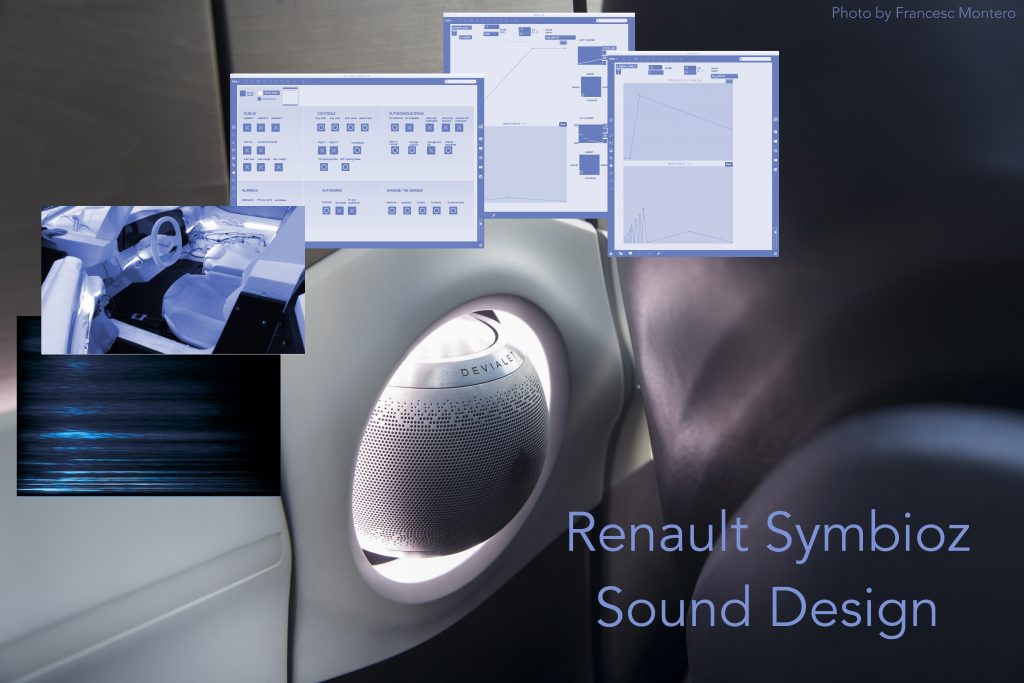Renault Symbioz Sound Design

BETTER SOUND 2018 | Category: Research & Development
Entrant
Andrea Cera
Abstract
We present the sound design process developed during the making of a self-driving electric demo car, the Renault Symbioz (unveiled in 2017, Frankfurt Motor Show). The project offered two challenges: the design of an external sound to warn pedestrians of the vehicle’s presence, and the design of a collection of sounds for the car’s interior.
Project description
After unveiling a vision for 2030 with the concept car Symbioz at the Frankfurt motor show in September 2017, Renault gave journalists the chance to drive the Symbioz demo car. To curate the sonic aspects of this project, in 2016 an industrial collaboration was initiated between Renault’s Design/Innovation Lab departments, and IRCAM’s Sound Perception and Design Team, represented by engineer Nicolas Misdariis, and sound designer Andrea Cera.
Symbioz represents a fusion of vehicle and living space. The care for the passenger’s comfort and peace of mind coexists with the experimentation of new technologies for controlling the car’s behavior, internal atmosphere and feel. The project offered two sound design challenges : the design of an external sound to warn pedestrians of the presence of the car (sound signature), and the design of a collection of sounds for the car’s interior (cockpit sounds).
The sound signature is diffused when the car’s speed is between 0 and 30 km/h – a speed range in which the electric car is potentially silent. Its features are derived from two previous projects by the same team, the sound signatures of Renault Trezor (a concept-car) and Renault Zoé (a commercialized model).
The nature of Symbioz’s sound signature is a hybrid of electric and turbine components, with a trace of a powerful but not aggressive internal combustion engine. When the car is idling, it emits sequences of soft, short and high-pitched sounds, creating an abstract language (from the emerging behavior of audio agents), and warning pedestrians that the car is switched on. The sound was prototyped in Max-MSP and converted to a proprietary algorithm.
Symbioz is a laboratory for studying the future of cockpit sounds. We have developed a series of innovative sonic Human-Machine Interfaces (HMI), in two distinct directions.
- exhaustiveness – we processed all driver/passenger/cockpit interactions related to Symbioz’s modes of functioning. The availability of a self-driving mode creates new design challenges : how to communicate the levels of autonomy of the car? How to reassure the passengers that everything is OK when the car is self-driving? To manage the large number of needed HMIs we created a prototyping tool in Max-MSP.
- spatiality – we developed an original concept of spatial sonic HMI.
Every sound played in Symbioz’s cockpit (blinkers, alarms, info sounds…) is placed in a virtual acoustic space. The car has three modes of use (Classic, Dynamic, Autonomous). In each mode the sounds slightly move around virtual positions, with different degrees of jitter and reverberation. For instance, in Dynamic Mode the blinkers are firmly placed in the direction the car will take. In Autonomous Drive Mode the blinkers are oriented much loosely, since no passenger is focused in driving. By moving in space, HMIs become less annoying and more natural – changes in position translate into subtle timbral shifts, due to phasing and reflections in the cockpit walls.
Project video